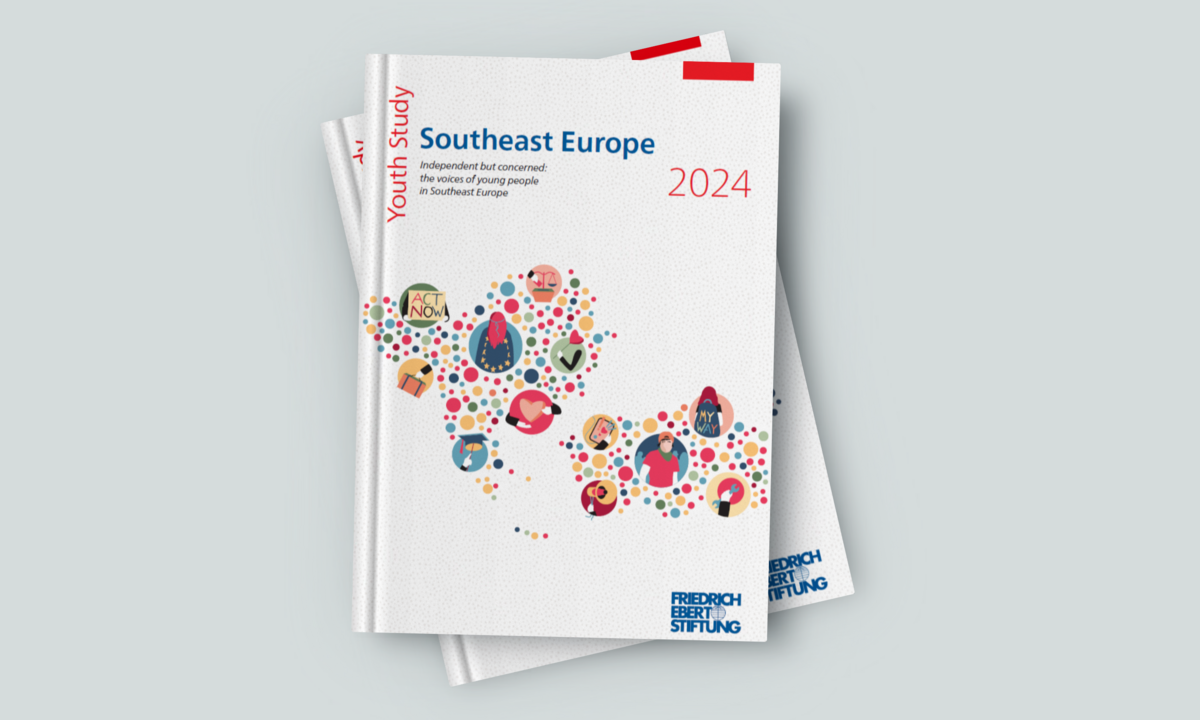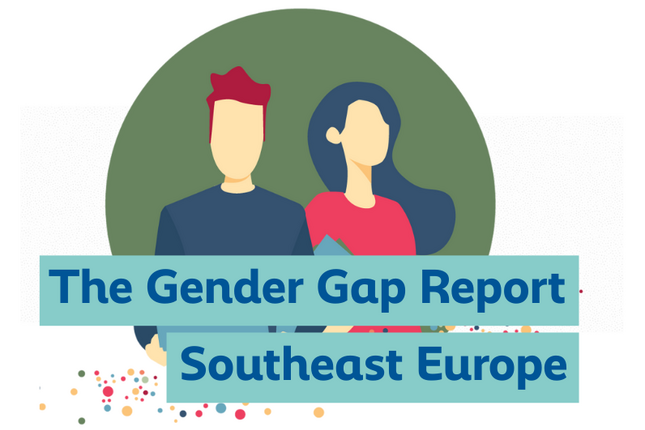
The Gender Gap Report Part 5: When Jobs Are Scarce, Who Deserves Them More?
The Economic Gender Divide in Southeast Europe
In times of economic scarcity, who should get priority access to jobs? For most young people across Southeast Europe, the answer is clear: employment should be allocated based on qualifications and need, not gender. But a significant minority—particularly among young men—still believes that when jobs are scarce, men should have more right to work than women. This view, though rejected by most, reveals an undercurrent of traditional thinking about gender roles in the economic sphere that varies noticeably across the region.
The Friedrich-Ebert-Stiftung's 2024 Youth Study asked nearly 9,000 young people across twelve Southeast European countries whether they agree that "when jobs are scarce, men should have more right to a job than women." The responses expose not just a gender gap in attitudes, but a web of relationships between employment experiences, economic pressures, family planning, and beliefs about who deserves economic opportunity.
This fifth installment in our Gender Gap series examines how young Southeast Europeans think about gender and employment in times of persistent economic uncertainty. The findings reveal clear and consistent patterns in some areas—particularly around age and career ambition—while showing more varied patterns in others related to economic circumstances and family planning.
A Moderate Overall Gender Gap Masks Regional Extremes
Across Southeast Europe, 16.4% of young men and 9.5% of young women agree that men should have priority access to jobs when they are scarce—a gender gap of 6.9 percentage points. These regional averages, however, conceal variations between countries that reflect different political trajectories, cultural traditions, and gender equality progress.

The country-by-country comparison reveals the full spectrum of gender divides. Montenegro and Slovenia lead the region with the largest gender gaps—over 11 percentage points separating young men from young women in their support for male job priority. In Montenegro, only 3.8% of young women agree compared to 16.3% of men. Slovenia shows a similar pattern with 4.2% of women versus 16.0% of men.
Albania presents a different pattern: while it shows the third-largest gender gap (11.1 percentage points), both genders show higher absolute support—22.6% of men and 11.5% of women—indicating more widespread traditional attitudes overall. This contrasts with countries like Montenegro and Slovenia where low female support drives the gap.
At the other extreme, Turkey shows the smallest gender gap at just 1.3 percentage points, but this reflects high baseline support from both genders—23.7% of men and 22.5% of women agree men deserve priority. Serbia (4.8pp), Bosnia and Herzegovina (5.0pp), and Greece (5.1pp) also show relatively modest gender differences, though Greece achieves this through low support from both genders (9.9% men, 4.8% women) while Turkey shows convergence at high levels of traditionalism.
The Full Picture: Most Young People Reject Job Priority for Men
Looking further into agreement rates reveals that outright rejection of male job priority is the majority position across Southeast Europe, particularly among young women. The full distribution of responses shows that 60-85% of young women across most countries actively disagree that men should have more right to jobs when scarce.
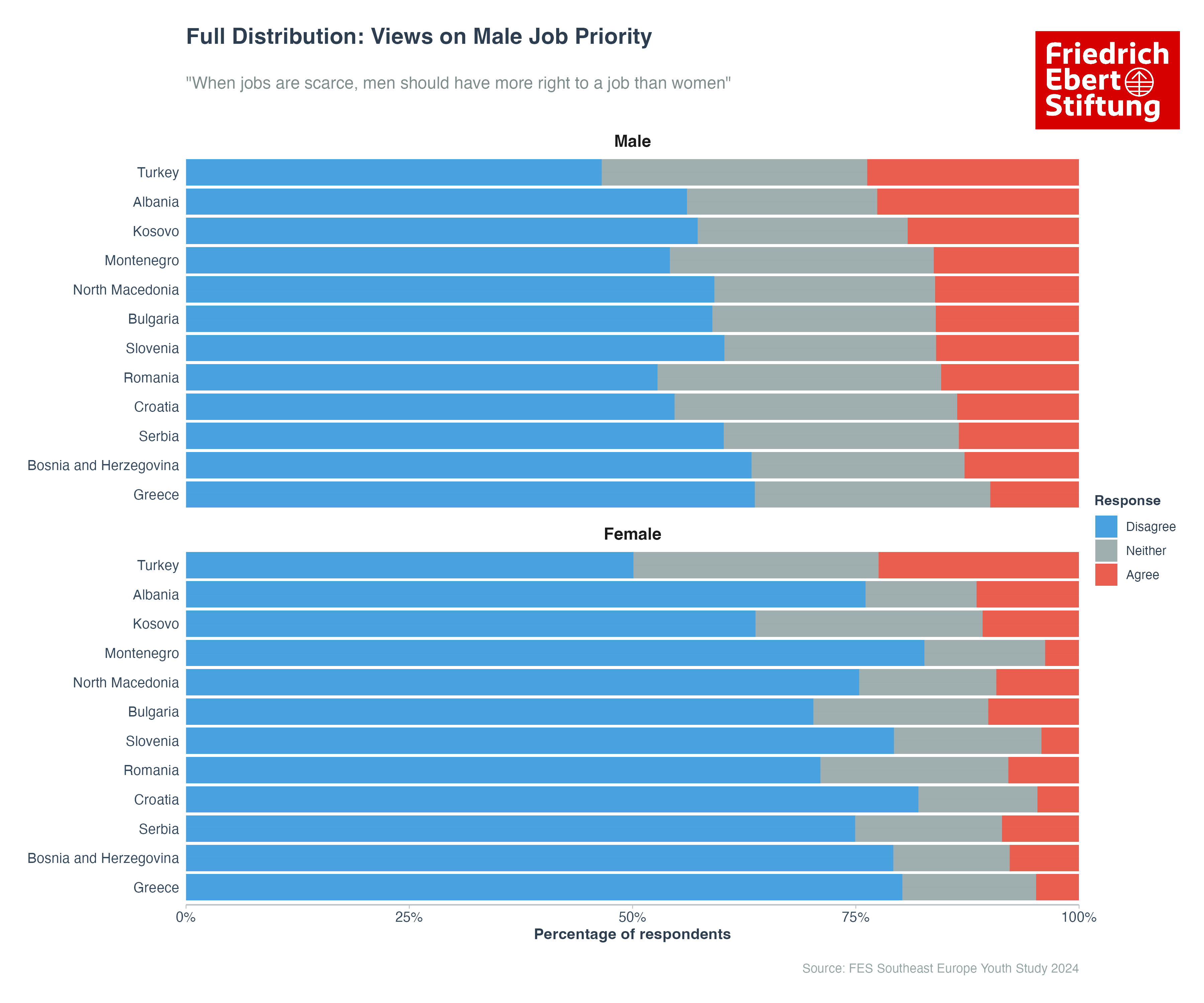
Young men show more varied patterns. In countries like Greece, Croatia, and Slovenia, clear majorities of young men also reject male job priority. But in Turkey, Albania, and Kosovo, substantial minorities of men—between 19% and 24%—actively support prioritizing men's employment. The "neither agree nor disagree" category, typically capturing 15-30% of responses, suggests many young people hold ambivalent or context-dependent views rather than firm ideological positions.
Age Shows Clear Patterns, Education Less So
Age emerges as one of the most important factors shaping attitudes about male job priority. Support for male job priority increases substantially as young people move from adolescence into adulthood, and this increase is particularly pronounced among young men.
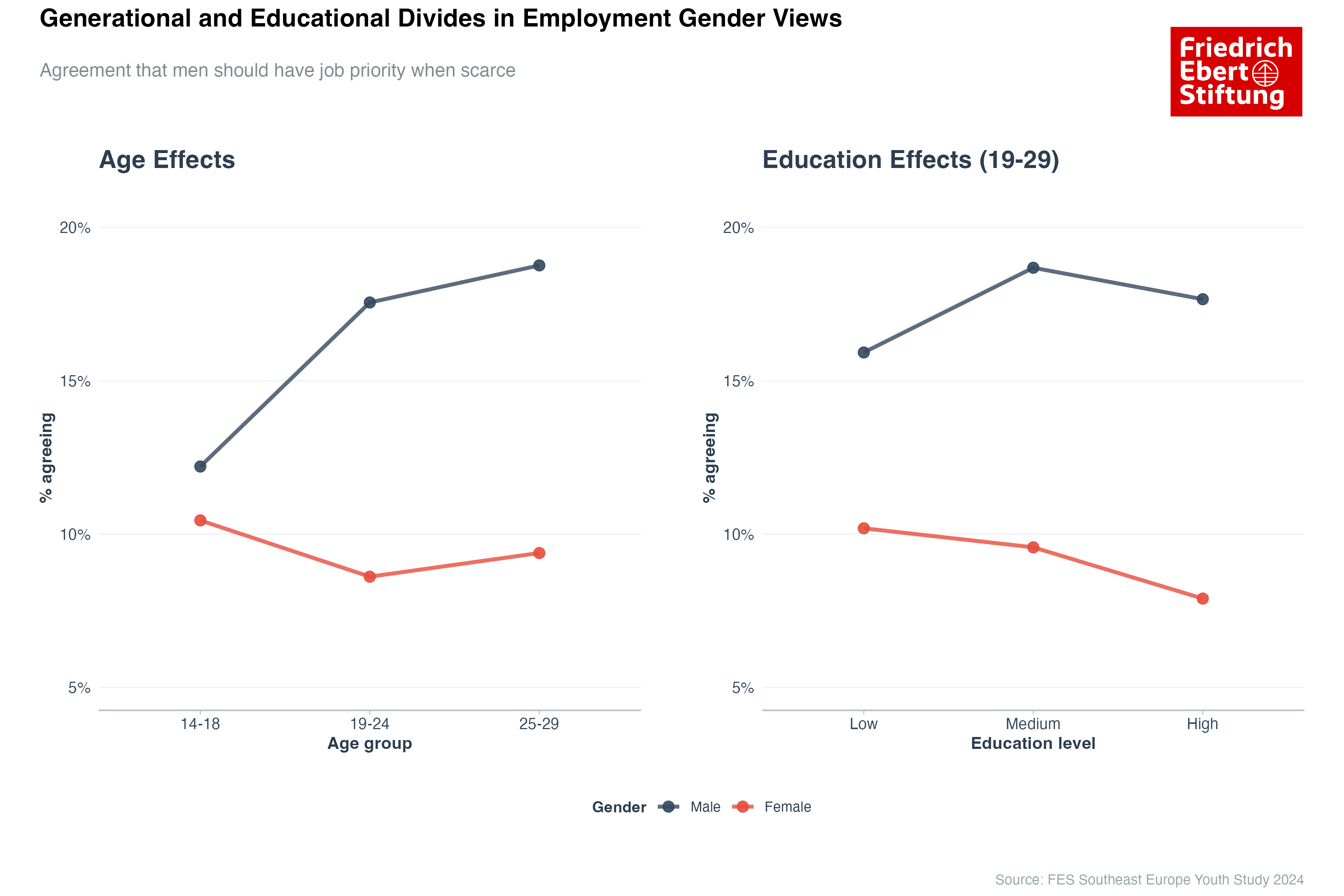
Among 14-18 year olds, 12.1% of young men support male job priority compared to 10.4% of women—a modest 1.7 percentage point gap. This gap widens significantly among 19-24 year olds (17.4% vs 8.5%, an 8.9pp gap) and remains elevated for 25-29 year olds (18.8% vs 9.4%, a 9.4pp gap). The pattern suggests that entry into the labor market and confrontation with actual employment scarcity may shape gender attitudes, particularly among young men competing for limited opportunities.
Education shows less consistent patterns. Among 19-29 year olds, those with different education levels show somewhat varying attitudes, but the differences are modest and inconsistent. While higher education correlates with slightly lower overall support for traditional employment hierarchies among women, it does not eliminate the fundamental gender divide in how young men and women view competition for scarce jobs.
Employment Status Shows Modest Differences
Employment status shows some relationship with attitudes toward male job priority, though the patterns are modest. Among employed youth, 19.0% of men and 9.9% of women agree with male job priority. Among unemployed youth, these figures are 14.7% of men and 9.9% of women.
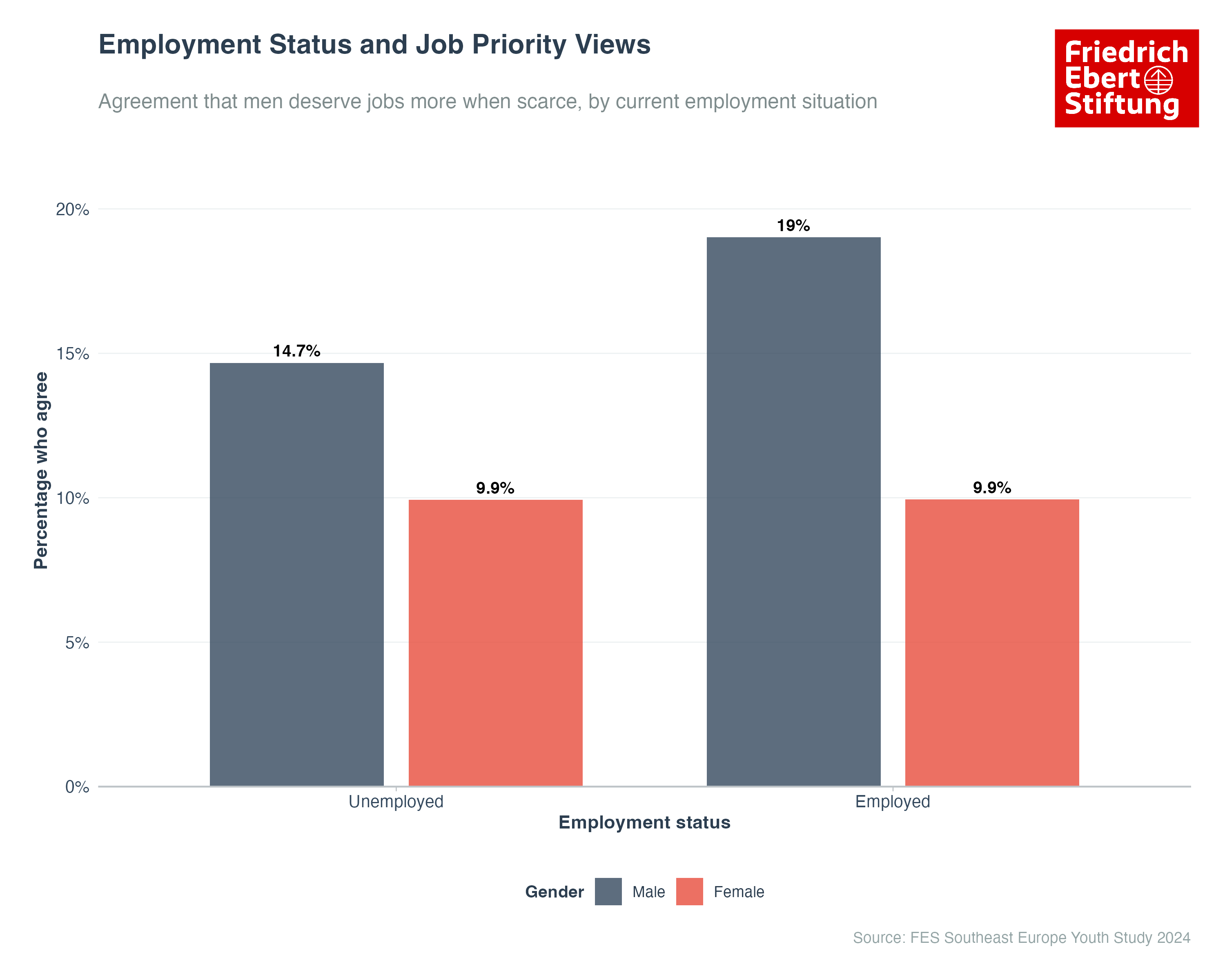
The gender gap remains consistent across employment statuses at around 9-10 percentage points, suggesting that employment circumstances affect men and women similarly. The slightly higher support among employed men compared to unemployed men hints that labor market success may not automatically promote egalitarian attitudes, though this difference should be interpreted cautiously given the relatively small magnitude.
Economic Circumstances Show Descriptive Patterns
Looking at household financial circumstances provides additional context, though the patterns observed should be understood as descriptive associations rather than definitive relationships. Young people from struggling households show somewhat higher levels of support for male job priority compared to those from comfortable backgrounds.
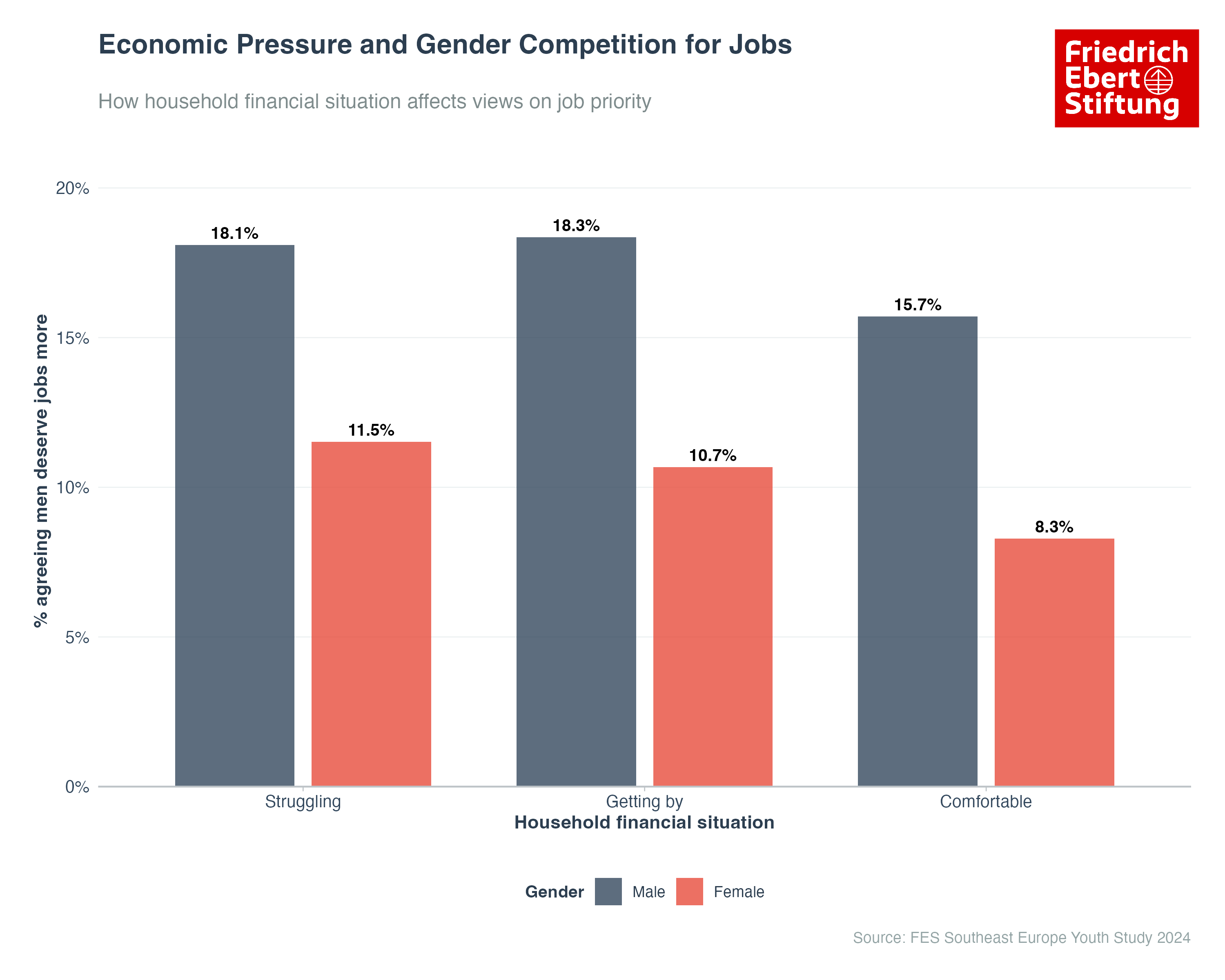
Among youth from struggling households, 18.1% of men and 11.5% of women support male job priority. These figures are 18.3% and 10.7% for those "getting by," and 15.7% and 8.3% for comfortable households. The gender gap remains relatively consistent across financial categories, at 6-7 percentage points.
While these patterns might suggest that economic precarity activates traditional attitudes about gender roles, the relationships are complex and other factors also play more important roles in shaping these views.
The Intersectional Picture: Employment and Finance Together
Examining employment status and financial circumstances together reveals the complexity of how multiple dimensions of economic experience relate to gender attitudes. The heatmap visualization shows how support for male job priority varies across different combinations of employment and financial circumstances.

Among employed men from struggling households, 20% support male job priority—the highest rate in the matrix. Unemployed men from struggling households show 17% support. Women show more consistent patterns across employment categories, with struggling women showing 11-12% support regardless of employment situation.
Career Ambition Creates a Gender Paradox
Perhaps the most striking finding concerns career ambition. As career importance increases for young men, so does their support for male job priority. As career importance increases for young women, their support for such priority decreases. This creates a divergent pattern where those most invested in careers hold opposite views about whether gender should matter in employment allocation.

Among men who rate career as important, 17.6% support male job priority. This drops to 14.2% for neutral and 11.5% for those who rate career as unimportant. For women, the pattern reverses: 11.3% of those rating career as unimportant support male priority, declining to 10.0% for neutral and 8.9% for those who consider career important.
Career-oriented men may view male job priority as aligned with their ambitions—either seeing male success as natural or viewing reduced female competition as beneficial. Career-oriented women, conversely, recognize that male priority directly threatens their own opportunities, leading them to reject such hierarchies more firmly than women with lower career investment.
The divergence illustrates how identical experiences (career ambition) produce opposite attitudinal outcomes depending on whether one benefits from or is harmed by traditional gender hierarchies. It also suggests that as more young people of both genders pursue serious careers, gender conflict over employment allocation may intensify rather than diminish.
Family Planning Shows Suggestive Patterns
Plans for having children show some interesting descriptive patterns in relation to employment attitudes, though these relationships are not definitive. The data show variation in support for male job priority across different family planning intentions.
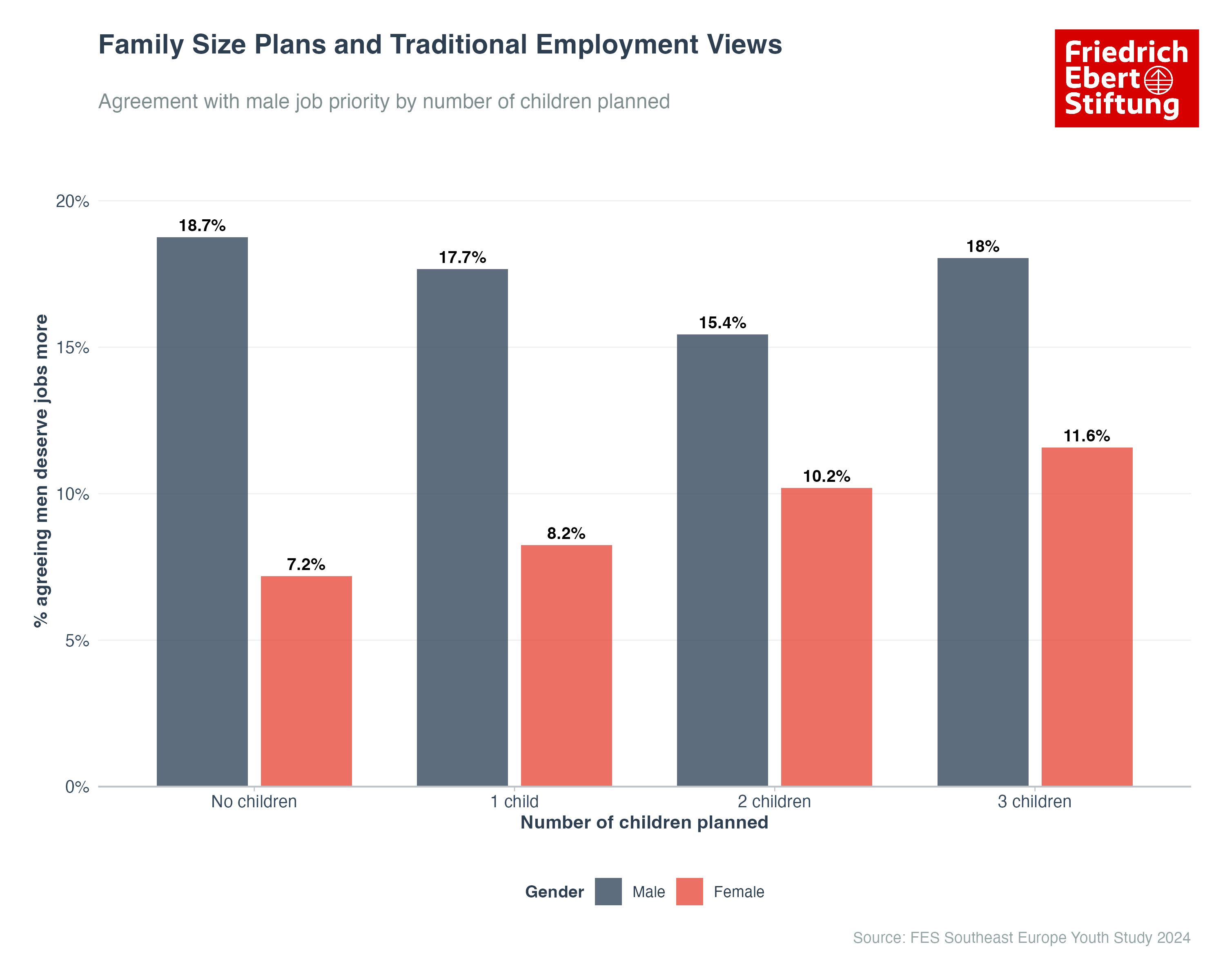
Among men planning no children, 18.7% support male job priority. This varies to 17.7% for those planning one child, 15.4% for two children, and 18.0% for three children. Women show a more consistent gradient: 7.2% of those planning no children support male priority, rising to 8.2% for one child, 10.2% for two children, and 11.6% for three children.
The gender gap persists across all family planning categories but appears somewhat smaller among those planning larger families.
What We Can Say with Confidence
The statistical analysis reveals which patterns are most robust. The gender gap itself is highly consistent and significant—young men across Southeast Europe are substantially more likely than young women to support male job priority in nearly all contexts examined. This gap varies significantly by country, ranging from just over 1 percentage point in Turkey to more than 12 percentage points in Montenegro, and these country differences are among the most reliable findings.
Age effects are also clear and consistent: support for male job priority increases substantially as youth move from adolescence (14-18) to young adulthood (19-29), and this increase is particularly pronounced among young men. The gender gap widens dramatically between these age groups, indicating that labor market entry is a critical period for the formation or strengthening of gender attitudes about employment.
The career ambition paradox represents another robust finding: as career importance increases for men, their support for male job priority increases; as career importance increases for women, their support decreases. This creates divergent trajectories among the most ambitious youth that has important implications for future gender relations in competitive labor markets.
Other patterns observed—relating to employment status, financial situation, family planning, education, and urban-rural location—show descriptive variation in the data but do not pass tests of statistical significance. These factors may play roles in shaping attitudes, but their effects are less consistent and may be influenced by other unmeasured variables.
Implications for Labor Market Policy and Gender Equality
These findings reveal several important patterns for employment and gender equality policies in Southeast Europe. While not all observed relationships are definitive, the strongest and most consistent findings point to specific challenges that merit policy attention.
The Age Pattern's Clear Challenge: One of the most robust findings is that support for male job priority increases substantially as youth move from adolescence through their twenties. This pattern is particularly pronounced among young men and suggests that labor market entry may shape rather than challenge traditional gender attitudes. Employment and entrepreneurship programs for youth should explicitly address gender equality rather than assuming that increased opportunity will naturally produce egalitarian outcomes. The transition from adolescence to young adulthood appears to be a critical period when attitudes about gender and employment allocation become more polarized.
The Career Ambition Divergence: The divergent effects of career ambition on men's and women's attitudes present a clear policy challenge. As career ambition increases, young men become more likely to support male job priority while young women become less likely to do so. This creates opposing trajectories among the most career-oriented youth. As societies encourage both genders to pursue ambitious careers, they may inadvertently increase gender conflict over employment allocation unless explicit attention is paid to how career-oriented men understand their interests in relation to women's labor market participation.
Country Context Matters: The substantial variation across countries, from Montenegro's 12.5 percentage point gender gap to Turkey's 1.3 point gap, indicates that national contexts significantly shape these attitudes. One-size-fits-all regional approaches to gender equality in employment may be less effective than country-specific strategies that account for local political trajectories, cultural contexts, and ongoing gender equality debates.
Conclusion
The question for Southeast Europe is whether societies can develop shared understandings of merit and fairness that transcend gender-based allocation of opportunity. The substantial country variation suggests multiple pathways are possible, but the persistence of gender gaps—particularly among older, career-oriented youth—indicates that achieving true equality in employment attitudes will require sustained attention to how young people, especially young men, are socialized to understand their relationship to female economic participation.
Perhaps most concerning is the timing revealed by the age patterns. The transition from adolescence to young adulthood, when labor market competition becomes real rather than abstract, appears to crystallize rather than challenge traditional gender hierarchies. As Southeast Europe continues to grapple with youth unemployment and economic uncertainty, the risk is that scarcity itself becomes the justification for inequality. Whether the region's young people can build labor markets where gender truly does not matter may depend less on economic growth alone and more on whether societies can actively counter the tendency for competition to activate traditional hierarchies about who deserves what when opportunities are limited.
About the Data
This analysis draws from the Friedrich-Ebert-Stiftung's Southeast Europe Youth Study 2024, examining attitudes among 8,943 young people aged 14-29 across Albania, Bosnia and Herzegovina, Bulgaria, Croatia, Kosovo, North Macedonia, Montenegro, Romania, Serbia, Slovenia, Greece, and Turkey.
Related publication
Hasanović, Jasmin ; Lavrič, Miran ; Adilović, Emina ; Stanojević, Dragan
Youth study Southeast Europe 2024
independent but concerned: the voices of young people in Southeast Europe

